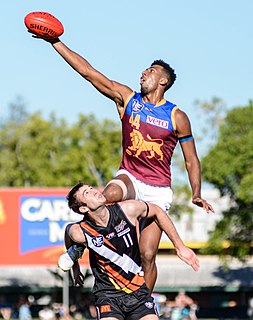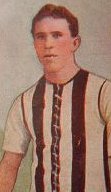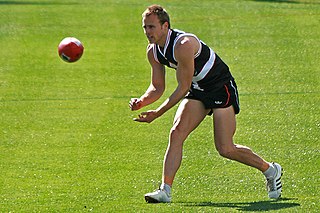| Eric Tassie | |
|---|---|
| President of the Australian National Football Council | |
| In office 4 November 1929 –4 November 1935 | |
| Preceded by | Alf Moffat |
| Succeeded by | Bob Rush |
| Personal details | |
| Born | 12 October 1887 Adelaide, South Australia, Australia |
| Died | 21 July 1936 (aged 48) Adelaide, South Australia, Australia |
Eric Harry Tassie (12 October 1887 – 21 July 1936) was an Australian rules football administrator. He was president of the Australian National Football Council (ANFC) from 1929 to 1935.

Australian rules football, officially known as Australian football, or simply called Aussie rules, football or footy, is a contact sport played between two teams of eighteen players on an oval-shaped field, often a modified cricket ground. Points are scored by kicking the oval-shaped ball between goal posts or between behind posts.

The Australian National Football Council (ANFC) was the national governing body for Australian rules football in Australia from 1906 until 1995. The council was a body of delegates representing each of the sport's individual state leagues which controlled football in their states. The council was the owner of the laws of the game and managed interstate administrative and football matters. Its function was superseded by the AFL Commission.
Tassie was a son of Henry Tassie, who was a government minister in South Australia. [1] He attended Way College, Adelaide, and played football for the school team and later for various lower-level clubs. An accountant by profession, Tassie became manager of the Norwood Football Club's B-grade team in 1912, and then in 1914 was elected club treasurer. [2] He became club secretary in 1919, holding that position until 1924, and was a club delegate to the South Australian Football League (SAFL) [lower-alpha 1] from 1920 until his death. [3] Tassie managed the South Australian state team at the 1924 National Carnival, [4] and was a state selector on a number of other occasions. [1]

Henry Tassie was an Australian politician. He was a member of the South Australian Legislative Council from 1918 to 1938, representing Central District No. 2 for three successive conservative parties: the Liberal Union, Liberal Federation and Liberal and Country League. He was Chief Secretary, Minister of Mines and Minister of Marine from 1927 to 1930 in the government of Richard Layton Butler.

South Australia is a state in the southern central part of Australia. It covers some of the most arid parts of the country. With a total land area of 983,482 square kilometres (379,725 sq mi), it is the fourth-largest of Australia's states and territories by area, and fifth largest by population. It has a total of 1.7 million people, and its population is the second most highly centralised in Australia, after Western Australia, with more than 77 percent of South Australians living in the capital, Adelaide, or its environs. Other population centres in the state are relatively small; Mount Gambier, the second largest centre, has a population of 28,684.

Adelaide is the capital city of the state of South Australia, and the fifth-most populous city of Australia. In June 2017, Adelaide had an estimated resident population of 1,333,927. Adelaide is home to more than 75 percent of the South Australian population, making it the most centralised population of any state in Australia.
After several years as a delegate from South Australia and a term as vice-president, Tassie was elected ANFC president at its general meeting in November 1929, succeeding Alf Moffat of Western Australia. [5] He held the position until November 1935, when he resigned and nominated Bob Rush of Victoria as his successor. [6] During his presidency, Tassie was known for his flexibility with regard to the laws of the game. He presided over the reintroduction of the flick pass for the 1934 season, [7] and at one point suggested tackling should be banned in order to free up the flow of play. [8] Tassie died unexpectedly in July 1936, aged 48, while undergoing an operation on his mastoid process. [1] After his death, the Tassie Medal was struck in his honour, to be awarded to the best player at each Australian National Football Carnival. [9]
Alfred Augustine Moffat was an Australian sportsman and sports administrator. He played first-class cricket for Western Australia and Australian rules football for several clubs in the West Australian Football League (WAFL). After retiring from playing, he served as president of the WAFL from 1920 to 1932, and was also president of the Australian Football Council (AFC) from 1924 to 1929.

Western Australia is a state occupying the entire western third of Australia. It is bounded by the Indian Ocean to the north and west, and the Southern Ocean to the south, the Northern Territory to the north-east, and South Australia to the south-east. Western Australia is Australia's largest state, with a total land area of 2,529,875 square kilometres, and the second-largest country subdivision in the world, surpassed only by Russia's Sakha Republic. The state has about 2.6 million inhabitants – around 11 percent of the national total – of whom the vast majority live in the south-west corner, 79 per cent of the population living in the Perth area, leaving the remainder of the state sparsely populated.

Robert Thomas "Bob" Rush was an Australian rules footballer who played for the Collingwood Football Club in the Victorian Football League (VFL).









